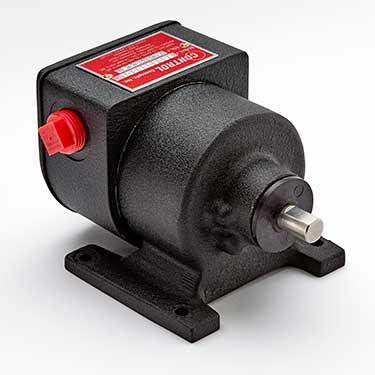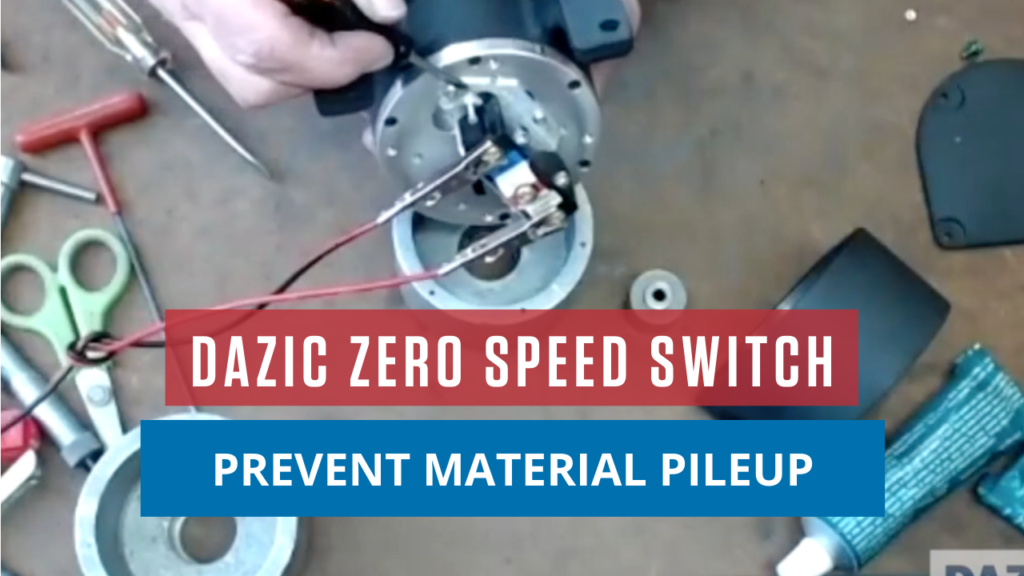Zero Speed Switch: Protect Equipment, Process and People
Comments Off on Zero Speed Switch: Protect Equipment, Process and People
A zero speed switch can help prevent material pileups and detect machine failure. Just like fire alarms, they are cheap, easy to install, and can quickly alert you of a problem and prevent thousands of dollars in damage.
What is a speed switch?
Speed switches are attached to rotating shafts to detect any abnormal change in rotation speed. These shafts are found in many types of plant machinery, from conveyor belts to rock crushers.
How do speed switches work?
Speed switches contain a non-contact inductive sensor probe positioned near the rotating object.
Small metal flags or magnets are mounted on a disc or pulser wrap, which generate pulses as they pass through the probe’s electromagnetic field. The pulses have a frequency proportional to the shaft RPM (rotations per minute).
This simple set-up can help detect any changes in speed. If the RPM does not match the speed trip-points that you have set – either it is moving too fast, too slowly, or stopped completely – a corresponding relay de-energizes and triggers an alarm.
To avoid nuisance tripping caused by normal pauses in speed (such as start-up or built-in time delays), the relay can be programmed to drop out only after a specified time. Some systems will need an external timer, while others can already have it built in.
Check out our video on DAZIC Speed Switches
How can a speed switch improve plant operations?
Prevent downtime
You can lose a whole day of productivity from shovelling material pile-up because an elevator or conveyor belt broke down. If the equipment breaks and the process stops, you’re paying your workers to sit around and do nothing, and essentially losing money.
Prevent wear and tear
Speed switches can prevent the misalignment of couplings, and stress/wear and tear of rollers and other small parts.
Detect machine damage before it becomes expensive to repair
Speed changes can be a sign that equipment needs repair or preventive maintenance. It’s cheaper to fix a small part now, than to replace equipment down the road.
Automate processes
Speed switches are sometimes used to initiate a secondary process once it reaches a particular speed or pre-programmed setting.
Prevent worker injury
The speed of operating equipment can play a big role in workplace safety. Speed switches can prevent accidents or injuries caused by malfunctioning equipment, spillage, or cleaning material pile-up.
Achieve accurate processes
Quality starts with precision. Keep your equipment running at the right speed and know the moment that there is a problem.
Where can I install a speed switch?
Speed switches can be installed on any device with a rotating shaft. This includes:
- Rotary valves
- Bucket elevators
- Belt, drag and screw conveyors
- Fans
- Blowers
- Saw blades
- Drive motors
- Mixers
- Crushers
- Agitators
- Rolling mills
What industries use speed switches?
Some of the world’s biggest companies use speed switches for smoother, safer, and more efficient plant operations.
- Grain, Feed & Milling
- Bulk Materials Handling
- General Manufacturing
- Ethanol/Biofuels Processing
- Sugar Processing
- Packaging
- Food Processing
- Textile Production
- Mining
- Power Generation Plants
- Water Utilities
- Wastewater
What are the different kinds of speed switches?
Zero speed switches differ in their set-up, features, performance specifications, mounting styles, and casings.
2-piece vs 3-piece system
Depending on your process, preferences, and considerations like space or the operating environment, you can opt for a two-piece system or a three-piece system.
A two-piece system only needs a speed switch and rotating target. A three-piece system has a speed switch, a rotating target, and a remotely mounted external sensor.
Technology used
- Electromechanical speed switches mechanically open or close a set of contacts
- Electronic zero speed switches use a lay and electronic circuit
- Magnetic proximity switches use a proximity sensor and a microcomputer
Special applications
Some zero speed switches are designed for harsh outdoor conditions or hazardous plant environments. They can be weather-proof, dust-proof, and explosion-proof. To determine if the zero speed switch you need will meet your specifications look at the product’s National Electrical Manufacturers Association (NEMA) ratings.
Performance and features
Speed switch models cater to different shaft input speeds. Some perform better for applications that have slower start-ups or operating speeds, while others can detect not just when a shaft stops but begins to rotate backwards.
Mounting
Switches need to be securely mounted and aligned to prevent damaging the bearings and causing premature product failure. Proper installation can include mounted brackets and couplings, internal flanges, or plug-in sockets with 8-pin termination.
Find out more about zero speed switches and the DAZIC line.






